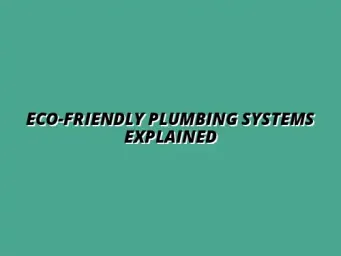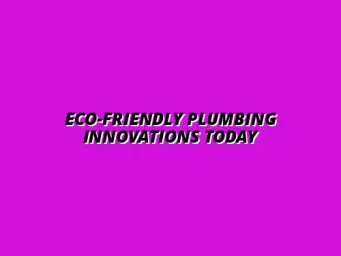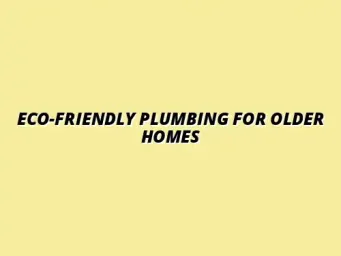Understanding Eco Plumbing and Its Role in Sustainable Home Building
Eco plumbing is a crucial element in sustainable home building. It focuses on integrating sustainability into plumbing systems without sacrificing functionality. By using innovative technologies and eco-friendly materials, eco plumbing aims to reduce water and energy consumption, ultimately contributing to a healthier planet.
As we delve into eco plumbing, it's important to recognize its impact on both the environment and the homeowner's overall experience. Sustainable plumbing practices can lead to lower utility bills, enhanced indoor air quality, and greater home value over time. The intersection of green choices and effective plumbing creates a win-win situation for everyone! For more information on maximizing water and energy savings in your home, check out these water-saving tips.
Defining Eco Plumbing: The Intersection of Sustainability and Functionality
Eco plumbing is defined by its commitment to conserving natural resources while ensuring that plumbing systems operate effectively. This approach emphasizes:
- Water efficiency: Utilizing fixtures and appliances that consume less water.
- Energy savings: Incorporating systems that minimize energy usage.
- Non-toxic materials: Using safe substances that don't harm indoor air quality.
By focusing on these aspects, eco plumbing strives to create a system that benefits both the homeowner and the environment. It's a balancing act that requires careful planning and consideration of the materials and technology used.
Key Characteristics of Eco Plumbing Systems
Eco plumbing systems possess several key characteristics that set them apart from traditional plumbing. These features include:
- Low-flow fixtures: Designed to reduce water use without compromising performance. Learn more about the benefits of eco-friendly low-flow plumbing fixtures.
- Graywater recycling: Systems that capture and reuse water from sinks and showers.
- Solar water heaters: Utilizing renewable energy sources to heat water efficiently.
These characteristics not only help to conserve resources but also make homes more comfortable and cost-effective. When you adopt eco plumbing practices, you're making a significant commitment to a sustainable lifestyle.
Comparing Traditional Plumbing to Eco-Friendly Alternatives
When comparing traditional plumbing with eco-friendly alternatives, the differences become clear. Traditional plumbing often uses outdated fixtures and materials that waste resources, while eco plumbing focuses on:
- Efficiency: Lower water and energy consumption.
- Healthier environments: Reduced exposure to harmful chemicals.
- Long-term savings: Decreased utility bills and maintenance costs.
This transition to eco plumbing not only benefits homeowners financially, but it also plays a pivotal role in promoting a sustainable future for our communities. Regular maintenance is key to prolonging the life of your plumbing system; consider this water heater maintenance checklist for optimal performance.
The Rise of Green Home Construction and Its Environmental Impact
In recent years, green home construction has gained momentum as more people become aware of the environmental impact of their choices. With rising energy costs and increasing concern about climate change, homeowners are looking for ways to build sustainably. Eco plumbing is a vital component of this movement, aligning perfectly with architects and builders focused on creating energy-efficient homes.
As green building practices continue to evolve, eco plumbing remains at the forefront, offering innovative solutions that minimize environmental footprints. By adopting these practices, homeowners can contribute to a healthier planet while enjoying the numerous benefits of sustainable living! Discover the numerous advantages of eco-friendly plumbing for homeowners by visiting this page.
Trends in Sustainable Building Practices
Several trends are shaping sustainable building practices today, including:
- Smart home technology: Integrating systems that optimize resource use.
- Renewable energy sources: Utilizing solar and wind power in new constructions.
- Recycled materials: Incorporating salvaged materials into building designs.
These trends enhance the eco-friendliness of new homes while providing homeowners with modern conveniences. By keeping up with these emerging trends, builders can create homes that are not only sustainable but also appealing to potential buyers. For example, regular drain cleaning can prevent costly repairs and improve efficiency; learn more about the benefits of regular drain cleaning.
How Eco Plumbing Supports Green Building Certifications
Eco plumbing plays a crucial role in helping homes achieve green building certifications, such as LEED (Leadership in Energy and Environmental Design). These certifications require adherence to strict guidelines regarding energy efficiency, water conservation, and sustainable materials. Eco plumbing supports these certifications through:
- Water-efficient fixtures: Essential for meeting water conservation standards.
- Energy-efficient systems: Contributing to overall energy performance ratings.
- Use of sustainable materials: Ensuring that all plumbing components are eco-friendly.
By integrating eco plumbing into new constructions, homeowners can significantly increase their chances of earning these prestigious certifications while promoting environmentally responsible practices. Seasonal maintenance is also important; check out these seasonal bathroom plumbing maintenance tips.
Real-World Applications and Case Studies of Eco Plumbing
When it comes to understanding the effectiveness of eco plumbing, real-world examples can speak volumes. Numerous green homes have integrated these innovative plumbing systems, showcasing their potential for sustainability and functionality. By examining these success stories, we can see how eco plumbing not only meets modern plumbing needs but also contributes to a healthier environment.
Success Stories: Green Homes That Utilize Eco Plumbing
Several homes around the world have adopted eco plumbing techniques, leading to impressive results. These success stories highlight the benefits of sustainable practices and serve as inspiring examples for other homeowners.
- Case Study: Green Roof Home - This home features a green roof that captures rainwater, which is then filtered and reused for irrigation, significantly reducing water waste.
- Case Study: Off-Grid Living - A family living off-grid utilizes composting toilets and rainwater harvesting systems, showcasing how eco plumbing can lead to self-sufficiency.
- Case Study: Modular Eco Homes - These homes have been designed with eco-friendly plumbing systems that minimize energy consumption and promote water conservation.
Case Study: A Look at Award-Winning Sustainable Home Designs
Recognizing that sustainability is the future, several award-winning homes have embraced eco plumbing. For instance, the Green Building Council's recognized projects highlight the integration of eco plumbing with renewable energy systems. This combination creates a self-sustaining environment, resulting in lower emissions and energy costs.
These homes utilize systems such as:
- Greywater recycling - Reusing water from sinks and showers for landscape irrigation.
- Low-flow fixtures - Reducing water usage without sacrificing performance.
- Solar water heating - Using sunlight to heat water, which lessens reliance on traditional energy sources.
Lessons Learned from Eco Plumbing Implementation in Real Projects
From the experiences of homeowners who implemented eco plumbing, we can derive valuable lessons. Many found that careful planning and education were crucial for success. Additionally, the importance of selecting the right products and technologies cannot be overstated.
Some key takeaways include:
- Engaging certified professionals from the start eases the installation process. Finding a reliable plumber is crucial; consider searching for a plumber in your area.
- Researching and selecting products that align with specific sustainability goals boosts efficiency.
- Incorporating community support can enhance awareness and acceptance of eco plumbing solutions.
Challenges and Solutions in Implementing Eco Plumbing
Despite the clear benefits of eco plumbing, homeowners often face challenges during installation. Understanding these obstacles can lead to better planning and smoother implementation. Common issues include high initial costs, limited availability of eco-friendly products, and a lack of knowledge regarding installation.
Common Obstacles Homeowners Face During Installation
It's essential to recognize the hurdles that can arise when transitioning to eco plumbing. Some of the most frequently encountered challenges are:
- Cost concerns - Eco plumbing systems can sometimes require a higher upfront investment.
- Product availability - Not all regions have easy access to eco-friendly plumbing products.
- Installer expertise - Finding certified professionals with eco plumbing experience can be challenging.
Strategies for Overcoming Challenges in Eco Plumbing Projects
Fortunately, there are effective strategies to navigate these challenges. Taking proactive steps can ease the process and ensure successful implementation. Here are some strategies homeowners can consider:
- Research grants and incentives - Many governments offer financial assistance for eco-friendly upgrades.
- Network with local eco builders - Connecting with others who have experience with eco plumbing can provide valuable insights.
- Participate in community workshops - Education through workshops can better inform homeowners about eco plumbing options.
Taking Action Toward Sustainable Plumbing Practices
Now that we’ve explored real-world applications, it’s essential to consider how homeowners can take action toward implementing eco plumbing practices in their own lives. By arming themselves with resources and knowledge, they can make informed decisions that benefit both their households and the environment.
Resources for Homeowners Interested in Eco Plumbing
There are various resources available for homeowners eager to embrace eco plumbing solutions. Whether seeking professional installation or DIY options, these resources can provide essential guidance.
Finding Local Eco Plumbing Experts and Contractors
One of the first steps is to find qualified professionals who specialize in eco plumbing. Homeowners can:
- Search online directories for certified eco plumbers.
- Ask for recommendations from local building supply stores.
- Join community forums to connect with others who have hired eco plumbing experts.
Educational Resources: Workshops, Webinars, and Online Courses
Education is key to making informed choices about eco plumbing. Homeowners can take advantage of:
- Workshops - Many local organizations offer free or low-cost workshops on sustainable building practices.
- Webinars - Online seminars hosted by eco plumbing experts can provide valuable information from the comfort of home.
- Online courses - Platforms like Coursera and Udemy offer courses on eco-friendly home construction, including plumbing.
Encouraging Broader Adoption of Eco Plumbing in Communities
To truly make a difference, it’s important to encourage wider acceptance of eco plumbing practices among communities. By raising awareness and advocating for sustainable practices, homeowners can spark change in their neighborhoods.
Community Initiatives Supporting Eco-Friendly Building Practices
Many communities are already embracing sustainability through various initiatives. Homeowners can participate in or promote:
- Local sustainability fairs - These events can educate residents about eco plumbing and other green practices.
- Neighborhood clean-up events - Organizing or joining these efforts fosters community spirit and eco-friendly mindset.
- Collaborative projects - Working with local organizations can help implement eco plumbing solutions on a larger scale.
Advocating for Sustainable Plumbing Standards at Local Levels
Finally, advocating for sustainable plumbing standards can lead to significant change. Homeowners can:
- Engage with local government - Attend town hall meetings to discuss the importance of eco plumbing regulations.
- Collaborate with environmental organizations - Support efforts that promote eco-friendly standards and practices.
- Raise public awareness - Use social media and community newsletters to share the benefits of eco plumbing.
By taking these steps, we can collectively promote eco plumbing and contribute to a more sustainable future for our homes and communities!









